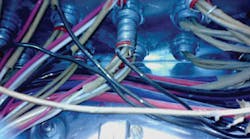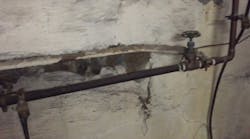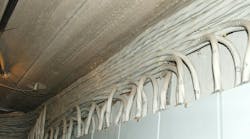As usual, never consider the following commentary associated with these photos as a formal interpretation of the National Electrical Code (NEC). Without criticizing anyone or any product, the following scenarios present us with serious safety questions.
All references are based on the 2008 NEC.
NOT SO FIT
An anonymous reader was working in a homeless shelter in Brooklyn, N.Y. that was built about three years ago. His work required him to open a flush-mounted circuit breaker panel on the top floor. When he opened the cover, he noticed the person who installed the armored cables entering the top of the panel used EMT connectors. “See how the armor passes right through the connector,” he says. “Yes, this job passed inspection.”
According to Sec. 300.15 (Boxes, Conduit Bodies, or Fittings — Where Required), “Fittings and connectors shall be used only with the specific wiring methods for which they are designed and listed.” EMT connectors are not designed to be used with a cable assembly. The loose terminations would be of no value if they were called upon to serve as an equipment-grounding conductor.
GOOFY METHODS
“A flexible raceway for a motor connection was used to stop any motor vibration from being transmitted to the structure,” says Larry Bentley, a senior electrical engineer, Technical Facilities Engineering and Standards, with Verizon Business in Dallas. “The installer put a gray metal cabinet under the open chase that was too tall, so they actually disassembled the chase and left all the cables lying on top of the metal cabinet and spilling over into the rest of the chase.”
There are lots of goofy installation methods used here by an unqualified person. The lack of the proper terminations and use of correct fittings adds to the misery. The lack of grounding and bonding continuity violates many rules noted throughout Chapter 3 of the NEC for the wiring methods they used, including Art. 250. In addition, the installer did not use an enclosure where wiring methods and splices are typically enclosed in a properly sized box.
Found a Code Violation? E-mail your photos (no cell phone images, please) to Joe Tedesco at [email protected]





